Delightful Philippines – Around El Nido (Palawan)
We walk along Calle Hama, El Nido's beach road, towards our boat trip meeting point. Nahlee, my Thai wife, beams and points to street hawkers: They sell freshly caught fish.
"That's a good one! For soup or grilling."
A plastic bag with 5 fresh mackerels goes for 1.5 USD.
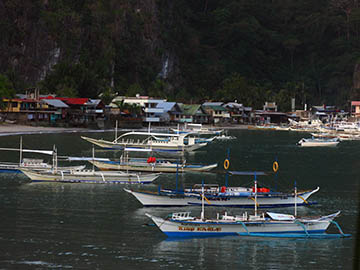
|
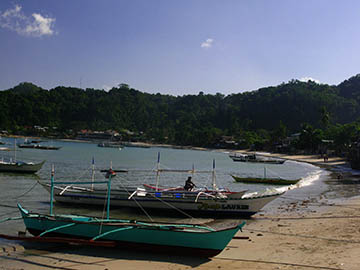
|
Tour A, Tour B, Tour C
We did our three day long boat outings with El Nido's travellers' HQ, the El Nido Boutique & Artcafé. It's 15 USD per person including a barbecued lunch, salad and Nescafé, but excluding water or soft drinks and snorkeling equipment (coke 1 USD, beer 1.12 USD, snorkel & mask rental 2.5 USD a day, fins another 2.5 USD).
The sizable outrigger banka boat can't get right onto the dark grey town beach sand. Instead we have to wade through the El Nido beach water that (guessing from the trickle out of our hotel) is full of sewage. We depart with a delay, but we also return at 5 pm, one hour later than forecasted.
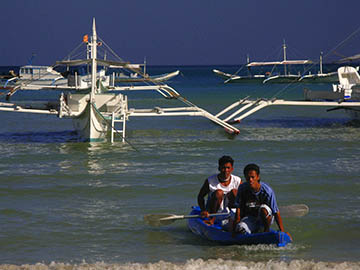
|
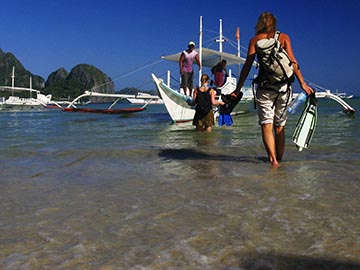
|
Our first stop is at Miniloc island in a bay surrounded by very impressive limestone cliffs. The rather shy, young guide announces that we've reached Small Lagoon and mumbles something else. Only thanks to instructions from other westerners we learn that there's another Big Lagoon awaiting. You swim through an ark in the rocks – and enter another enclosed, rock-walled lagoon. Lazy Nahlee and I came with swim-vests and hang, literally, out in the waters, tommy-up, holding hands, our eyes wandering around the pitch black, jagged towering cliffs, spotting one or another Palawan eagle up above. It's a lovely lovely place, but I'd say that Coron island, off Coron town, 200 kilometers north, with Twin Lagoon, Barracuda and Kayangan Lakes has even more magic (and can be dipped too).
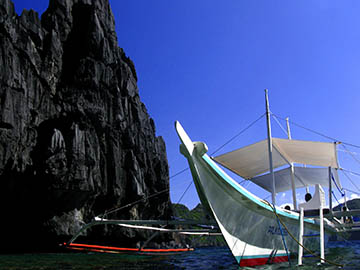
|
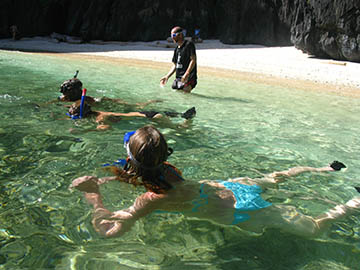
|
On we zoom, and soon we pass one of the remote El Nido Resorts where according to the guidebook accommodation starts from 165 USD per person per night. Their beach is crammed with unattractive, cheap looking buildings.
A striking, slim beach on Simisu island makes our lunch stop. There are few trees, but the cliffs tower so high that we get good shadow. Suddenly Nahlee beams and points to our guide: He brings fish for barbecue, and it's just the mackerels we saw in the morning.
But now she worries something: "This fish can only be grilled to 80 percent of the normal time. If you do more, it quickly changes to something like wood." I suggest she takes control of the procedures, as she frequently does in Thai eateries, but here she's shy. But the guide grills the fish perfectly right – even to critical Nahlee's content -, and salad and rice are okay too. Nahlee of course has brought her own chili to spiceless Phililand, and she even shares one with a spice-hungry US tourist. She also has bought oranges and apples for us, and she had ordered the fruit vendor in town to pre-cut the oranges for us.
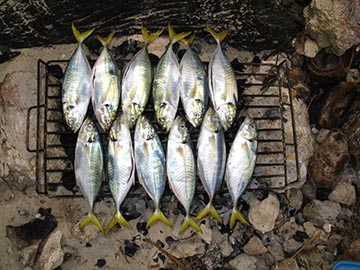
But each single fish is quite small, and some tourists don't get a second one. It's clearly a budget tour, so there are other weaknesses. The boat has no visible trash bin. The wooden lunch board (a ground level table) with all the food is placed in the middle of the sand, so that tourists have to sit right on the sand (possibly with sandflies), even though there are inviting rocks and driftwood trunks nearby. Only Nahlee and I brought life-vests to sit on (after we forgot the mat and sarong in the hotel). There are no tissues provided. All that is much weaker than a speedboat tour off Ao Nang or Ko Lanta in Thailand, but also much cheaper and somewhat more personal.
A few other tour boats stop by too. They are from luxury resorts where all trips are included in the price, and it's always only two tourists and two boatmen. The boatmen build up plastic tables and plastic chairs and fill them with porcelain plates and glass carafes. They must know that these tables stand exactly under a monkey inhabited tree (our guide had warned against monkeys there). Just when the rich tourists start munching a monkey attacks and runs off with expensive food. There is a Filipina who talks good Swiss-German and upon the monkey robbery produces quite a shriek in the solemn bay.
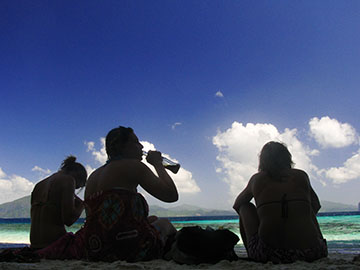
|
|
Back to Miniloc Island’s Secret Lagoon. We climb through a hole in the rocks and – enter another pirates’ dream beach. Partly you walk through waters peppered with extremely spiky corals and rocks, it’s easy to injure yourself, good sandals are a must.
The last stop is at stunning 7 Command Beach, for once a sandy beach without underwater rocks or slimery so splashing is good clean fun here. But like on many boat trips in Thailand and in the Phils, it’s a west facing beach visited in the afternoon, so there’s little escape from the sun.
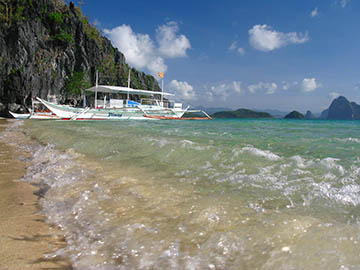
|
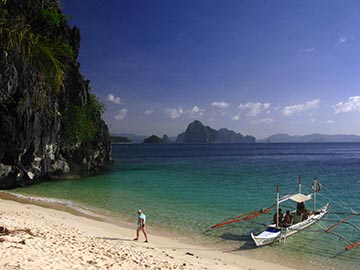
|
Around the corner and past Cadlao island we return to El Nido town (on big Palawan island, the namesake of Palawan province) and wade ashore through the probably unclean water. We have to go back to the tour shop and pay the trip. Yes, only now we pay. We are asked what we had rented and how many optional softdrinks? Instead of queuing up for paying, you could easily walk away even with your rental snorkel, but here in quiet solid El Nido, this isn’t expected. Not even from budget tourists.
Nahlee Takes to the Water
The boat stops offshore for snorkeling. There’s an island in sight but we may not land – it’s a private luxury resort. Without asking, the guide hands life jackets to a Filipina gal, a Korean gal and to my Thai gal, but not to the Swiss gal. And he assumed right: all Asian ladies can't swim, while the lady from landlocked Switzerland takes to the South China Sea like a shark whale on Birchermüesli.
Nahlee is still very sceptical about the whole swim thing. Why swim, she may think, when fish can conveniently be bought on the market?
On her very first tries in the Philippines (she never tried in Thailand) even with life jacket on she didn’t enter areas where she couldn’t stand. That was at Double Lagoon on Coron island, off Coron town. But the lagoon had been so blue and so amazing that she finally let me convince her to swim through the rocky hole and into that second lagoon, with life jacket of course, but only for ten minutes of dangling in the dreamy blue waters, upon which she urged back to banka.
So now here our offshore stop isn’t ideal for Nahlee to develop more swim fun. Nahlee would need some ground to stand on.
I get wet and discover almost next to the banka a large, rounded stone that’s high enough for standing with even Nahlee’s head remaining above water line. And yes, after that find she joins me and swims around even over deeper waters with her swim jacket. For Nahlee, that’s an achievement already. But dangling in the open waters about three meters deep, she refuses to use the mask to look at all the submarine protein bombs.
"No, this water is too deep, I am too scared if I see everything clear down there."
On her very first swims with mask she had been overjoyed to see not beautiful, but delicious and expensive fish in good sizes. She gestured me the sizes from far away and later commented on market price and use (soup, grill, fry, steam) (we both don’t like raw).
Only later she got an eye for underwater eye candy.
"Oh dear, so many beautiful fish!”
Note: Without discussing edibility of spotted subjects!
"And some beautiful, eh, stone flowers!!"
"That’s corals, dear.”
On her first days she used only the mask – but not the snorkel. The boat men happily instructed Nahlee and the Filipina gal, who was also new to that, how to use the snorkel, but Nahlee needed some more days to get accustomed. Actually, I believe her initial problems with two different snorkels stemmed from half-broken rental equipment.
On the night after tour B Nahlee suddenly laughs out loud in her sleep, rolls around, and then it seems to turn into a scream. I wake her up which takes about a minute.
"What did you dream, darling?"
"Oh, many many fish, darling, so wonderful!"
More Touring
Cudugnon Cave is on tour B, if I remember right. We squeeze ourselves through a small whole in the rock. We arrive in something of a natural rock church, at least 20 meters high and ten by ten meters wide. Light floods in from up above. There is no water in this cave, but after we have squeezed ourselves out again, the next beach inviting for a splash and more snorkle-snorkle is a mere 15 meters away.
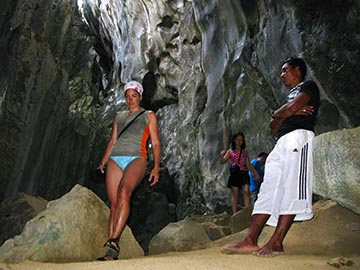
Then our boat approaches Cathedral Cave. This is a swim-in cave. But we cannot jump into the sea, because the waters are full of jellyfish. A slim sports boat from a luxury resort simply drives into the cave. Our large outrigger cannot do that. Quite often in those boat trip days, we can’t get real close to land or other destinations and have awkward times waddling ashore, as the banka is so inconveniently big.
The banka passes another isolated luxury resort, this time El Nido Resort Lagen Island. It’s squeezed in between unattractive rocks that block a lot of sea view and even has a huge ugly concrete wavebreaker built into the sea.
As we pass, the resort just starts a boat with checked-out customers, departing to El Nido airport (the airport can be reached by boat). In a moving choreography, ten or twelve resort staff stand on the pier and wave their luxury customers goodbye. Between the cheering staff and their departing customers our own backpacker banka shoots, and now *we* wave the waving staff hello – they wave on, even though their motions now mainly reach us and not the luxury departers.
The last stop is on tiny Inabuyatan island with yet another stunner beach, swaying palm trees and turquoise waters. While Nahlee practices her new-found love for fish spotting, I chat with the tour guide. The young guides on our tours look a bit rough and macho, but they all come from local El Nido fishing families and are more than helpful and happy to relate whatever they know about their home turf – and they know every fish and every rice field. My guide, 21 years old, married and father of one, says that Inabuyatan island was sold in 1980 from native fishing people to the rich family that owns the Petron gas station in El Nido. The new owners decided to keep the island undeveloped for the time being.
"How much did they pay for the island back in 1980?"
"3000 pesos."
"What – that's just 75 US dollars!"
"But in 1980 3000 pesos was worth much more than now."
"How much – could you buy a house?"
"No."
"A motorcycle?"
"Well – about the engine."
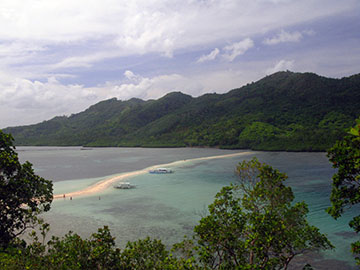
|
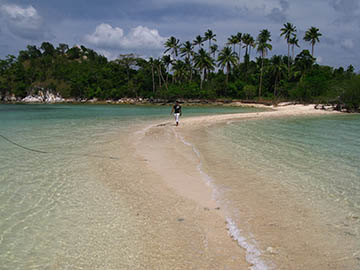
|
Snake island is another stop on tour B. A thin, winding sand bridge winds connects two islands, or is it two parts of one island? In this maze of island, isles and bizarrely contoured islets, all sprinkled around large and meandering Palawan island, I often don't know if we have changed island or just bay, if we stand on a small thing or on yet another outreach of Palawan island, the relative mainland. At first I do ask the guides about every island and beach name and try to follow the route on the map; but from the second boat trip on I don't inquire so much and feel better then.
The sand bridge has dark sand though peppered with pebbles and broken shells – it's obviously just a cheap copy of Krabi's Chicken island, off Ao Nang.
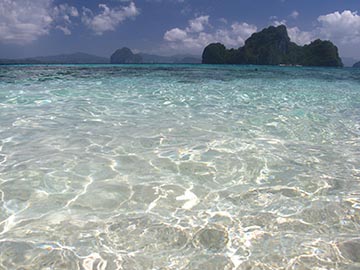
|
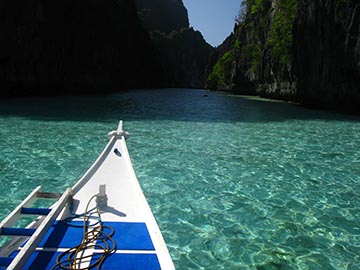
|
And as the banka sputters off to yet another wet destination, the tourists on board start to discuss that eternal important question: What's better – the bizarre rocky beaches and islands in Thailand’s Krabi or the bizarre rock beaches in the Philippines’ North Palawan's Bacuit archipelago? I’ll run a general Thai versus Philly beaches comparison later this year, but for now I’ve got this ultimate
Editorial: Krabi vs. Palawan Rocky Beaches
If you can stand the claustrophobic crowds on Krabi's Phra Nang beach, on Ko Hawng, on James Bond Island, Bamboo Island, Chicken and Hen Island and on Ko Phi Phi, then these fantastic places have more, shall I say, character or iconic quality than their Filipino rivals. I mean the sheer natural features, not the resorts, tour shops and sputtering longtail boats.
Those southern Thai landmarks are powerful like Monument Valley or Grand Canyon, at least on the Asian traveler’s mind. The cliffs in the Phils may tower even higher than in Thailand's Krabi, Trang or Satun provinces, and the Philly lagoons are more enclosed and unusual. The screaming white sand and the majestic black cliffs crash every histogram, the water’s a turqouise hallucination. Yes: the Phils’ Bacuit Archipelago, off El Nido, is very very very nice. VERY nice.
But the undoubted, convincing tenners and stunners in the Rocky Beaches department are Krabi and Pha-Nga Bay.
It’s been for a reason that Hollywood chose to stage “The Man with the Golden Gun” partly in the Pha-Nga Bay between Thailand’s Phuket and Krabi provinces. For “The Beach”, location scouts spotted Maya Beach near Thailand’s Ko Phi Phi, Krabi province.
Not the Phils.
This special Thai Rocky Beaches quality comes at a high price though: To see the southern Thai beauties, you lodge in overrun, generic Thai beach ghettos like Ao Nang or Kata Beach, constantly haunted by Indian tailors and tuktuk drivers and local culture seems to consist of BOOK NOW, BOOK HERE signs. While in the Palawans, most tourists base themselves in unexcited unexciting supersafe small towns like Coron or El Nido where your only haunt are the sweet hello kids in the side streets.
Into El Nido Town
The tricycle from airport to town is a fixed 150 pesos (3.75 USD) for 3 miles on a newly paved road. The driver drops us near a coffee shop. I give a 200 pesos bill. He heaves down our bags and says
"Thank you, bye bye sir."
"Do you have change?"
"Oh yes, sir."
Grin.
50 pesos appear.
While Nahlee guards our luggage in the coffee shop, I shop for accommodation. The rooms available are even worse than described in the Lonely Planet: One upstairs room with sea view goes for 30 USD – but has cold water, fan and squat toilet only. Another place is beach front – but has no window to the sea. No kidding. If you want air-con, fridge and hot water, you have to pay dearly. We finally end up in the very new El Nido Beach Hotel for 82 USD/night. At least we get a nice balcony onto beach and Bacuit Bay and perfect mosquito screening for two windows, so we sleep with a breeze and ocean hum.
Opposite the El Nido Beach Hotel – on the far side of the beach – stands their identical sister building, where the balconies in the familiar style go out to the street.
"So how much are the rooms on the streetside building", I ask the Korean owner?
"That's not our building! They just imitate our style. We are enemies!"
Later I learn from locals that this Korean owner himself has many enemies among the local Filipino population.
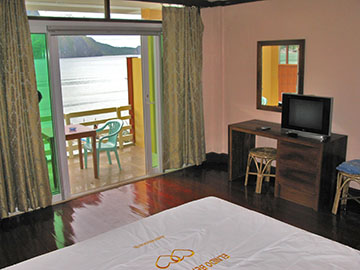
|
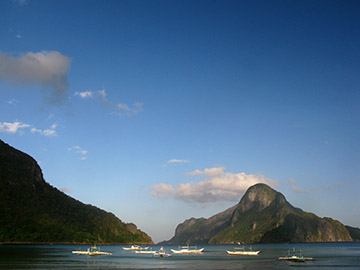
|
After reading the LP, the alternative to staying in town seems to be staying on an isolated beach or island in resorts where full board lodging including island hopping is charged with at least 80 USD – per person. I alone might enjoy this, but Nahlee needs to take to the market, buy soap, hair straps or oranges for the next boat trip. Actually, that’s ok for me too. I am anyway scared of isolated lodgings, as they may charge outrageously for laundry, internet or transfers.
After our first boat trip we return around 5.30 pm to our El Nido Beach Hotel. There had been no room service. Nahlee goes to reception who says "sorry, we only have one guy for room cleaning, but he will come right now". She rejects the offer, as now we are there already and yearn for shower and relaxation.
She asks for new towels and gets *one*.
Nahlee: "You know, we are two people."
She gets a second.
Later we learn that room service is only on demand, so every morning when we go out touring we ask for it. One time we request room service, but by accident keep the key with us when we go out. Coming home, we had no room service.
Our breakfast is spartan too. Three slices of toast, untoasted, with a glibbery butter emulation and nothing else. For hot drinks it's the usual BYO – brew your own Nescafé or Lipton tea at the hot water terminal; coffee whitening powder is supplied too. Alternatively they offer excellent, as the waitress claims, Korean instant coffee that comes with “coffee”, whitener and sugar all in one sachet; the brand, for instant coffee aficionados: Maxim Mocha Gold Mild Coffee Mix.
The poker-faced Korean owner enjoys a much better breakfast one table behind us.
Next morning we can't use our favourite table next to the water, because the Korean owner has blocked it with his bible. “He’s reading his bible there”, giggles a Filipino receptionist noticing that we can’t use our preferred table. The toast this time is grilled in a pan, according to Nahlee (there is no electricity in the morning). The waitress shows us where we have to take out cutlery from a box for ourselves. After which another waitress shows up and brings another round of cutlery for us. She also drop-lands "bananas from the Philippines – very good" with a demanding voice, and dutifully we down them. (Very good.)
Following the power supply times, the internet shops are only open from noon to 4 p.m. and after 6 p.m. The main internet service has some extremely rowdy, cold faced guys Slavian there any time, browsing Asian hard porn sites and shouting their newest finds to their buddies, past my frightened head.
I change shop and when I want to pay for my online time I notice that the cashier lady is a teenage looker. She seems nice and cute like any Asian good girl. Still something about her seems to indicate she won’t listen to mama at all times. Instead of naming a price she says:
"Where are you from, sir? How old are you, sir?"
"Why do you ask so many questions? How old are you then?"
"Just turned 18, sir", she smiles.
El Nido Town
The sand beach of El Nido town is slim, the sand gray and dirty, at one end is a busy harbour, and some of our hotel's wastewater obviously trickles openly into sand and sea. The whole beach is locked off from the beach road by low rise bungalows and hotel buildings. It feels a bit like Bophut on Samui's north shore, where another small town builds up along the beach, while the beach itself is not so important – only that Bophut has tons more style. Another vague comparison might be Ao Nang in Krabi, because both towns are locked by cliffs and mostly serve as jump-off points for outlying islands.
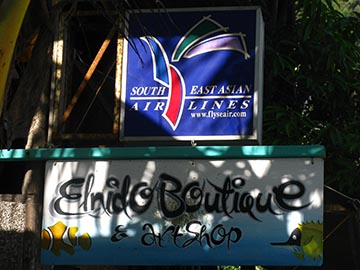
|
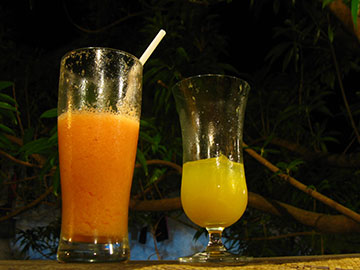
|
Walk the streets in the late afternoon, swifts – Spanish: el nido – fly low and swiftly across the streets of, yes, El Nido. Among all the unambitious food we got throughout the Phils, El Nido had some of the most unambitious of all. In other remote destinations we managed to locate at least one restaurant where we’d enjoy to return to next night. Not so in El Nido. Western run digs as well as Filipino places made feeling hungry a scary notion. Adobo (not Adobe) and other oily local favourites are pumped with sugar, cheap vinegar and garlic. The “pizza” at El Nido Boutique is a wobbly veggies cake. The banana shake there contains liters of sweetened condensed milk – as does the fruit salad at “Pura Vida, run by fam. Winkler” across the road on the sea front.
It’s not the ambiance. While PI restaurateurs couldn’t charm you with the stunning ambiance and setting as in Thailand – at least not in our price range – a few El Nido restaurants are nice and inviting enough. But remember the food they serve and you ponder a fasting week.
On the boat trip I had gotten befriended by a middle-aged Dutchman who enjoyed dropping malicious remarks about my country and figure with a smile. When I dipped he asked Nahlee to join him on the Phils, he’d have good work for her. He also explained how to find the Balay Tuay music pub – a place we didn’t manage to spot the previous night.
So on that evening we walk down El Nido’s Real Street almost to the harbour and there, with a hardly noticeable front, is the Balay Tuay (meaning House of Music in remote Cuyonan language). It’s a cosy little bar full of knickknack and paintings. Somehow it does have a Polynesian feel to it, which extends to the music of the three piece band. They play mellow folk songs, some I heard last from the Hawaiian band Ho’ikane.
The Dutchman had told me that on the previous night a Kiwi tourist brought his Manila gogo girl to Balay Tuay. When the band had raised the speed, the lady dropped her cottons and started to dance the table – upon which the band stopped playing because “we are not such a place”.
Right now Balay Tuay is rather empty and nothing untoward happening. When the door opens, it’s our friendly Dutchman. He comes alone and smiles at us, maybe in need of company/target. So when he approaches our table, eyeing the empty chair next to Nahlee with a questioning smile, I smile back and gesture to the next, totally empty table.
The cocktails at Balay Tuay are terribly oily and sweet, as is the halo-halo, Philippine style fruit salad (we had had decent halo-halo in Manila). You could even extend this description to the now melodramatic music, worsened by guitar and singer clearly out of tune. So before long we smile good-bye to the lone Dutchman and are back on the black, quiet night streets of El Nido again.
Town Beaches
El Nido's town beach is not for swimming, it's a walking beach where school kids and fishermen commute. El Nido town beach faces straight north. All other directs are blocked by the cliffs. So there are no sunsets, but through some cliff gaps Bacuit Bay still receives nice evening rays of light with various outrigger boats mooring, and presided over by towering Cadlao island in the back.
I stand in the sand right under our hotel balcony and try to get low-angle snaps of the lovely bay scene. While clicking away, I notice two giggling uniformed school girls in their checkered skirts watching me eagerly. When I smile at them, they giggle more until one manages to squeak "picture!"
"Oh, you'd like to take a picture, you two?"
Squeak, giggle.
Click, click.
Squeak, giggle.
"Bye bye, thank you!"
El Nido town’s lack of sunset will be more than compensated when you hop on a tricycle to Corong-Corong around 5 pm. The four km ride should only cost the equivalent of 25 US cents per head, but your driver may have to be reminded of that.
Corong-Corong is a semi-picturesque fishing village on a miles long, west facing beach. The sun sets dramatically in shades of yellow, red and violet amidst Bacuit Bay's wild rock islands with silhouetting bangka boats roaming the far end. Cheering local kids play in the sand and on palm trees and guess what, they'd love to get snapped.
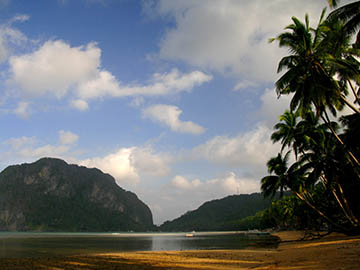
|
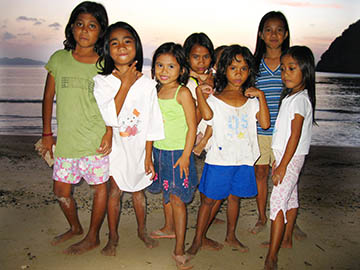
|
There are about two quiet, unobtrusive guest houses (not in the Lonely Planet), funny only that massive wooden fences block some beach view for the customers. They may shield the property from sandstorms. And there is lot and lot of undeveloped beach front land, as my enterprising Thai wife Nahlee has found out before long. Some of this land is covered with real coconut tree groves, a gorgeous look reminding me of southern Samui.
"Eh, Nahlee, this land… let's start Coconut Research Resort here!"
"No, I can't stay with Filipino food all the time."
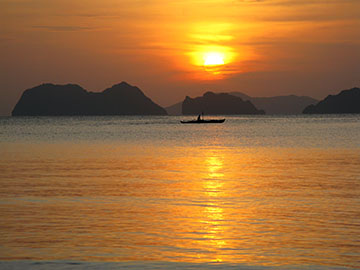
|
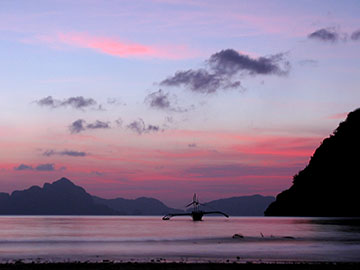
|
Early next morning we drive back to Corong-Corong and walk south with good tree shade. The beach is about 2 miles long. The low tide makes walking on the narrow sand strip easy, but it reveals another aspect too that's typical for most northern Palawan and even other PI beaches: Underwater, but close to the water line, there's slimy sea grass and spiky rocks. We see a few pockets with that trademark blue Filipino waters, but I guess the whole stretch looks much more inviting at high tide.
We have to climb around a very slippery rock promontory. It's the Phils, the world renowned underwater dive paradise and my cam, my one and only cam, my beloved snappy cam, ever so adventurous cam, which never took to any PADI course, my cam it departs on a spontaneous unattended reef dive. She had been off, but now, in the rock puddle, just two feet far from my desperately outreaching hand, under the surface, now my cam, my last and only cam, beloved happy snapper cam, slightly but tragically fatally submarine machine, carrying a carload of fresh fun beach pics inside, through her orange AF assist light she beams the Morse code, her terminate Mi Último Adiós.
Adiós compañera.
Finally we get to her, but we don’t even try decompression. With a broken, dripping cam dangling from my shoulder, we reach Las Cabañas Resort, where they cut most palm trees to plant a very colorful, but out-of-place garden with just few – unshaded – bungalows. The beach here has a natural sand bridge to an outlying island. This place can only be reached by boat or with a scenic 15 minutes bush walk from the main road (starting about 4 miles from El Nido town).
Still 20 sandy minutes further out is Dolarog Resort with quite inviting bungalows and a healthier palm trees population. And just around another corner you see yet another lone, sexy, curvy, dark blonde sand beach with just one exclusive resort in the distance, a semi-isolated setting like Relax Bay on Krabi's Ko Lanta. As I walk closer I realise it's not a resort, it's only a recycling workshop run by the hi-end El Nido Resorts.
Back in the Italian-run Dolarog Resort, the plain bitter, bodi- and crema-less espresso doesn't live up to our real-caffeine-starved yearnings, and cappuccino is not on offer. So why the pilgrimage. The menu sports about ten spaghetti and macaroni dishes. I'd love to introduce Nahlee to Spaghetti All' Americana, but it's too early and too hot for lunch (and who knows how they actually do it).
Guests at Dolarag and maybe also at Cabañas shuttle between airport and resorts by boat, some never see El Nido town and they are even unaware that the main road is in walking distance and a tuktuk or bus ride to town would only be a few pesos. Prices at both resorts start at around 80 USD *per person* per night including some meals, transfers and also boat trips.
Dolarog has one of the laziest waitresses I ever met in Asia; maybe she despises us as walk-in customers who most likely lodge much cheaper than at Dolarog. As we sit down in the cool, breezy resto sala, she gives us a lazy look and only a while later shuffles along, with an asking look, but empty handed.
"Do you have a menu", I enquire politely?
Lame nod.
Stands and waits.
Hmm.
"Can I see it?"
Lame nod. Shuffles off.
"Her boss must be out, she can't be like that all the time", believes Nahlee.
Five minutes later one menu is handed to me from behind. There is nothing of the slight, but pleasant formality that other Filo waiters exercise when handing menus or bills. Just tiredness. And it's only one menu, everywhere else we automatically get two. But then, only *I* had begged for a menu.
Waitress off and out of sight for 15 minutes. But then, she's brought the requested menu and how can she know I want to order something?
The calamansi juice comes without straw. But then, we haven't ordered juice with a straw.
I couldn't stand such a behaviour when shelling out big bucks expecting an all-round pleasant stay. But maybe she plays another role for resident customers and she's the resort's deterrent missile against the walk-in backpacker flotsam.
As we hike back towards the main road we peek into a few bungs. Dolarog bungalows have inviting, shady terraces with hammocks, big windows and are far from each other. Even though El Nido town moves heftily upmarket right now it has nothing pleasant like this. In one bungalow just being cleaned we see a bed with a very concave "third world" mattress.
"Those mattresses are less than 30 dollars", shudders my ever market-savvy Nahlee.
The companion slide show to this article is online, as is the report about our surpriseful return from El Nido to Manila.
Stickman's thoughts:
It looks and sounds like you had a great time. As keen as I am to visit the Philippines, your confirmation of the average food over there is one of a few things which puts me off the place. Still, I am sure there's a lot of fun to had, just as my Kiwi friend in the story showed!



